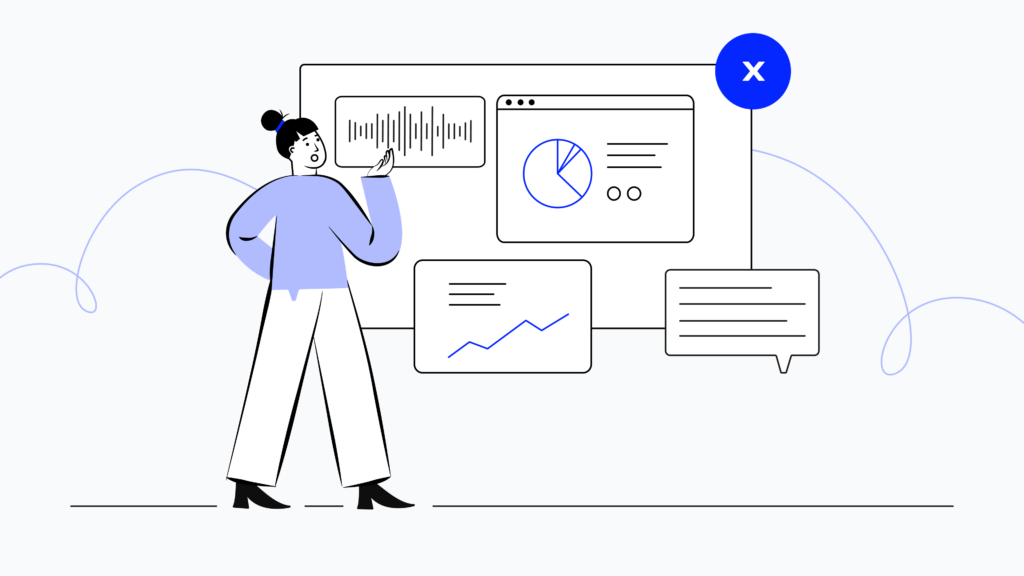Conference Bridge Call: The Connection to Better Meetings

A digital phone system helps the average mid-sized business save $1,727 per month in cell phone and long-distance charges. Are you reaping those benefits?1
For sales and support professionals, the answer goes beyond just cost savings. It’s about removing the barriers that prevent your team from hitting quota consistently. It’s about eliminating the technical frustrations that drain productive selling time.
And it’s about gaining visibility into performance metrics that traditional systems simply cannot provide.
This guide cuts through the technical jargon to explain what digital phone systems are, how they work, and most importantly—how they can transform your team’s ability to generate pipeline and close deals.
Key Takeaways:
- When selecting a digital phone system, prioritize solutions that integrate seamlessly with your existing tech stack, scale with your growth, and maximize agent productivity.
- Digital phone systems convert voice to data packets, allowing calls to travel through the internet rather than physical phone lines, resulting in average savings of $1,727 monthly for mid-sized businesses.
- Unlike traditional landlines, digital telephony provides advanced features like power dialers, international numbers, and CRM integrations that directly impact sales team productivity and performance.
Choose CloudTalk and get crystal-clear international calls, and advanced routing.
What Is a Digital Phone System?
Ever sat through an excruciating meeting where your sales rep explained how they lost a hot prospect because of a dropped call? Or watched your quarterly numbers tank because your team couldn’t reach international clients without racking up astronomical phone bills?
Phone frustrations kill deals. Period.
A digital phone system transforms your organization’s voice communication by converting analog voice signals into digital data packets. Unlike traditional landlines that rely on copper wires and physical infrastructure, digital telephony uses internet connections to transmit calls through servers and data networks.
Think of it as the difference between sending a letter through postal mail versus shooting off an email. Same message, radically different delivery method.
How Does a Digital Phone System Work?
Ever wonder what happens when your sales rep clicks “call” on their laptop while sitting in a coffee shop? The process is surprisingly elegant.
Digital phone systems convert voice into data packets through a process called packet-switching. Unlike traditional calls that require dedicated circuits, these digital packets can take multiple routes to reach their destination—similar to how a ride-sharing app finds the fastest route during rush hour.
The entire process happens in milliseconds—faster than you can say “closed deal.”
What makes this technology revolutionary for sales and support teams?
Step
What Happens
Why It Matters
1
Your voice enters a device (computer, smartphone, desk phone)
This is how your communication begins—capturing your voice.
2
Voice conversion technology transforms analog sound waves into digital data
Converts your voice into a format that can travel over the internet.
3
These data packets travel through the internet to cloud-based servers
Enables your voice to move quickly and efficiently across distances.
4
The cloud PBX routes the call to the recipient
Ensures your call reaches the right person, no matter where they are.
5
At the destination, digital packets transform back into sound
Converts your voice back to its original form for the listener
6
Your prospect hears you crystal clear, regardless of location
Delivers a seamless, high-quality experience—no matter the distance.
Flexibility and reliability
When Munich-based account executive Stefan needs to reach prospects in Singapore, Tokyo, and San Francisco in one morning, a digital system makes it happen without technical gymnastics or financial penalties.
The backbone of these systems—cloud servers and sophisticated algorithms—ensures 99.7% uptime. No more explaining to your VP why the entire sales floor went dark during end-of-quarter rush.
The sophisticated routing capabilities of modern business telephone systems mean your most promising leads always get priority treatment, while built-in analytics let managers track performance metrics in real-time rather than waiting for monthly reports.
For companies with remote or international teams, this technology eliminates the barriers that once made distance a liability rather than a strategic advantage.
CloudTalk’s essential benefit is its unparalleled flexibility in handling our requests. Whether we needed new numbers, verified caller ID or setting up number porting, they made it incredibly easy and efficient.
Ibrahim Imam CEO MENA & APAC at PlanRadar
What are the Components of a Digital Telephony System
Behind every successful call lies an ecosystem of components working in harmony. Understanding these building blocks helps explain why digital systems outperform their analog ancestors by every metric that matters.
Modern digital telephony systems comprise three core components: the brains (PBX), the network connections (PSTN gateways), and the endpoints (IP phones or software clients). Each plays a crucial role in delivering the reliability sales and support teams depend on.
Let’s break down these components without getting lost in technical jargon.
Private Branch Exchange
The PBX serves as the command center of your communication system. Think of it as air traffic control for your calls, handling routing, transfers, and features like call waiting or voicemail.
Traditional PBX systems required dedicated hardware installations that took up office space and demanded specialized maintenance. Their digital counterparts—cloud PBX systems—deliver the same functionality without the hardware headaches.
Cloud PBX systems also scale instantly. You can grow a team from 15 to 45 reps after a successful funding round. Adding users would take minutes rather than the weeks required for hardware procurement and installation.
Learn how a cloud PBX can transform your communication infrastructure while reducing costs
PSTN Connectivity
PSTN (Public Switched Telephone Network) connectivity bridges your digital system with the traditional phone network. This component allows digital calls to reach landlines and mobile phones regardless of whether they use digital technology.
The PSTN gateway converts digital signals back to analog when necessary, ensuring you can reach any customer, prospect, or partner regardless of their technology. This universal connectivity eliminates communication barriers that might otherwise limit your team’s reach.
For international sales teams, advanced PSTN connectivity provides local numbers in over 160 countries, giving your organization a local presence without physical offices.
Studies show prospects are 68% more likely to answer calls from local numbers2, making this capability a revenue driver rather than just a technical feature.
IP Phones
The devices your team uses to make and receive calls represent the visible front-end of your phone system for business. IP phones come in various forms:
- Physical desk phones with digital capabilities
- Softphones (software applications on computers)
- Mobile applications for smartphones and tablets
- Browser-based interfaces requiring no installation
This flexibility means Sarah, a sales manager, can start a call at her desk, transfer to her mobile during her commute, and finish from her home office without the customer experiencing any disruption.
For growing teams, the ability to use existing devices rather than purchasing specialized hardware accelerates onboarding and reduces capital expenditure. New sales reps can be fully operational within hours of joining, complete with call analytics and recording capabilities from day one.
Sales and support leaders don’t upgrade phone systems for the technology—they do it for results. Digital systems deliver measurable advantages that translate directly to revenue growth and operational efficiency.
The most compelling aspect? These benefits stack. Each improvement compounds the others, creating exponential rather than incremental gains in team performance.
- Dramatic cost reduction: Companies typically slash communication costs significantly when moving from traditional to digital systems. The elimination of hardware maintenance, international calling fees, and dedicated IT resources creates substantial savings.
- Infinite scalability: Add or remove lines within minutes rather than days or weeks. When teams expand after successful quarters, digital systems scale instantly without service disruption or equipment purchases.
- Location independence: Enable truly distributed teams with identical capabilities regardless of location. Top talent can work from anywhere while maintaining full visibility and accountability through integrated analytics.
- Deep integrations: Connect your phone system directly to your CRM, helpdesk, and other critical tools. Support teams reduce average handle time by eliminating manual data entry between systems.
- Crystal-clear reliability: Experience 99.7% uptime and superior call quality that eliminates the embarrassing “Can you hear me now?” moments that kill professional credibility.
- Advanced call routing: Direct calls to the right team member based on skills, availability, or customer value. Sales teams increase conversions by ensuring high-value prospects always reach the most appropriate agents.
- Real-time analytics: Monitor call volume, duration, outcomes, and other metrics as they happen rather than waiting for end-of-month reports. This visibility allows managers to make immediate adjustments rather than discovering problems weeks later.
- Enhanced security: Protect sensitive customer information with enterprise-grade encryption and security protocols that meet rigorous compliance standards, including HIPAA compliance for healthcare organizations.
- Reduced infrastructure: Eliminate the need for on-premises hardware, dedicated server rooms, and specialized maintenance staff. Operations directors can repurpose former server rooms into revenue-generating spaces.
- Power dialer capabilities: Supercharge outreach with advanced Power Dialer features that increase call volume substantially, turning your sales team into a high-efficiency prospecting machine.
Is the Digital Phone System Right for Your Needs?
Before jumping into any new technology, smart leaders assess fit. Digital phone systems offer tremendous advantages for many organizations—but clarity about your specific needs ensures the right decision.
Category
Traditional Phone System
Digital Phone System
Initial Cost
High (hardware investment)
Low (subscription model)
Ongoing Expenses
Unpredictable maintenance costs
Predictable monthly fees
Geographic Reach
Limited/costly international calling
Global coverage at flat rates
Scalability
Slow, requires hardware purchases
Immediate, software-based expansion
Remote Work
Limited off-site capabilities
Comprehensive support anywhere
Integration
Minimal or custom development needed
Extensive API connections to business tools
Analytics
Basic call logs only
Comprehensive performance metrics
Technical Needs
Specialized expertise required
Minimal IT involvement needed
Flexibility
Rigid, difficult to modify
Highly adaptable to changing needs
Reliability
Vulnerable to local outages
99.7% uptime with cloud redundancy
Security
Limited, often outdated protection
Enterprise-grade encryption and protection
Feature Set
Limited by hardware constraints
Continuously expanding capabilities
Learn how a cloud PBX can transform your communication infrastructure while reducing costs
How To Choose the Right Digital Telephony System for Your Call Center
Selecting the right digital telephony system can make or break your sales and support operations. Sales development leaders know that phone systems aren’t just utilities—they’re revenue-generating tools that directly impact quota attainment and team performance.
To understand how to pick the right system, let’s step into Jacqueline’s shoes for a minute. She’s a sales leader moving from
Prioritize Agent Productivity Tools
The best phone system eliminates friction from your reps’ workflows. Look for features that maximize productive talk time and minimize administrative burden.
Power dialers, one-click calling, and automatic call logging allow your team to focus on conversations rather than processes.
Like Jacqueline, you have to evaluate systems based on how they’ll impact your key metrics: calls per day, talk time, and conversion rates. Avoid solutions that require reps to toggle between multiple applications to complete basic tasks.
Demand Seamless Integration Capabilities
Your phone system must play nicely with your existing tech stack. Fragmented data creates blind spots that compromise decision-making and hinder performance.
Assess potential systems based on native integrations with your critical platforms—especially your CRM, marketing automation, and helpdesk solutions. Each manual data transfer between systems introduces errors and wastes time.
For instance, Jacqueline reported that tight integrations between phone systems and CRMs deliver the highest ROI. When evaluating options, request demonstrations specifically showing how the phone system works within your existing workflow rather than generic feature tours.
Evaluate Call Quality and Reliability
Nothing undermines sales efforts faster than dropped calls or poor audio quality. Every technical glitch erodes confidence and damages your professional image.
Demand specifics about uptime guarantees and redundancy measures. The standard 99.7% uptime translates to about 26 hours of potential downtime annually—understand how providers minimize and mitigate these periods.
Test call quality across different network conditions. International calls deserve special attention for teams targeting global markets. A system that performs flawlessly in ideal conditions but falters under real-world network variation will create frustration for your team and customers alike.
Consider Scalability and Future Needs
The system you choose today must support your organization tomorrow. Growth becomes painful when communication systems create bottlenecks rather than enabling expansion.
Evaluate potential solutions against your growth projections for the next 24-36 months. Can the system easily accommodate doubling your team size? What about expanding to new geographic markets?
Forward-thinking sales directors like Jacqueline factor in not just current requirements but anticipated needs as their sales motion evolves. When her company expanded into EMEA markets, having a phone system that offered local numbers across multiple countries provided immediate credibility with prospects and simplified compliance with regional regulations.The right business phone system doesn’t just solve today’s problems—it prevents tomorrow’s challenges from emerging in the first place.
Leverage CloudTalk to Maximize Results
When selecting your digital phone solution, prioritize systems that integrate seamlessly with your existing tech stack, offer robust reliability, and provide the productivity features your team needs to excel.
The right choice amplifies your team’s strengths while eliminating the friction points that hamper productivity.
Your new system will only be as effective as your employees’ ability to use it. Invest in comprehensive training for all staff members. Consider appointing “power users” in each department who can help their colleagues adapt to the new system.
Be prepared for some initial resistance or technical hiccups. Have a plan in place for addressing common issues, and make sure your IT team is ready to provide support during and after the transition.
CloudTalk’s digital phone system gives your team the tools they need to exceed targets consistently.
Sources
FAQs
What is the difference between a digital phone and a landline?
Landlines use dedicated copper wires to transmit analog voice signals, while digital phones convert voice into data packets sent over the internet. Digital systems offer advanced features, mobility, and significant cost savings that traditional landlines cannot match.
How do I know if I have a digital phone?
You’re using a digital phone system if your calls travel through the internet rather than dedicated phone lines. Signs include the ability to make calls from multiple devices, access to features like visual voicemail, and the possibility of using your system anywhere with internet access.
What is an example of a digital system?
CloudTalk is a prime example of a digital phone system that enables businesses to handle calls through the internet with features like power dialers, intelligent routing, and CRM integrations that traditional systems cannot provide.
What is considered a digital phone?
Digital phones include any device that converts voice to data packets for transmission over the internet—including VoIP desk phones, softphones on computers, and mobile apps that connect to digital phone systems.
How much does a digital phone system cost?
Digital phone systems typically operate on subscription models, with costs ranging from $15-50 per user monthly depending on features and call volume. This predictable pricing eliminates the large capital expenditures associated with traditional systems.





















